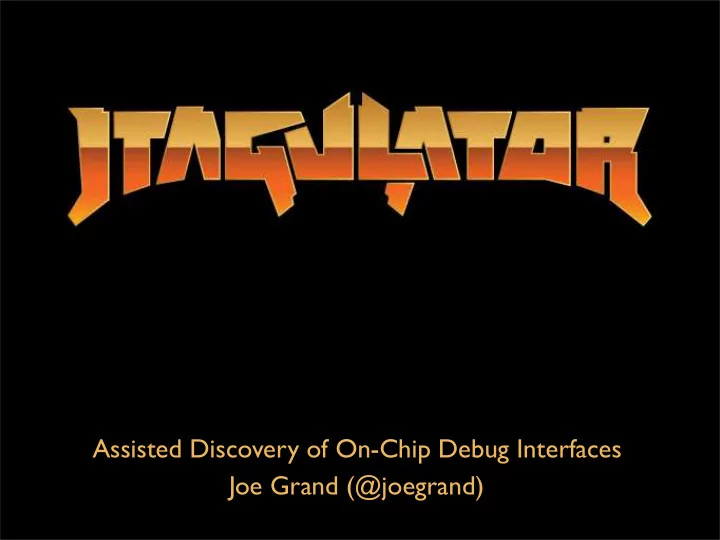

Assisted Discovery of On-Chip Debug Interfaces Joe Grand (@joegrand)
Agenda • Introduction • Inspiration / Other Art • Traditional HW RE Techniques • On-Chip Debug Interfaces • Design Requirements • Hardware • Firmware • Examples / Demonstration • Limitations • Future Work
Introduction • On-chip debug interfaces are a well-known attack vector - Can provide chip-level control of a target device - Extract program code or data - Modify memory contents - A fg ect device operation on-the-fly - Gain insight into system operation • Inconvenient for vendor to remove functionality - Would prevent capability for legitimate personnel - Weak obfuscation instead (hidden or unmarked signals/connectors) - May be password protected (if supported by device)
Introduction 2 • Identifying OCD interfaces can sometimes be difficult and/or time consuming
Goals • Create an easy-to-use tool to simplify the process • Attract non-HW folks to HW hacking
Inspiration • Hunz's JTAG Finder - http://elinux.org/JTAG_Finder • JTAGenum & RS232enum - http://deadhacker.com/tools/ • Cyber Fast Track - www.cft.usma.edu
Other Art • An Open JTAG Debugger (GoodFET), Travis Goodspeed, DEFCON 17 - http://defcon.org/html/links/dc-archives/dc-17- archive.html#Goodspeed2 • Blackbox JTAG Reverse Engineering, Felix Domke, 26C3 - http://events.ccc.de/congress/2009/Fahrplan/ attachments/1435_JTAG.pdf
Other Art 2 • Forensic Imaging of Embedded Systems using JTAG, Marcel Breeuwsma (NFI), Digital Investigation Journal, March 2006 - http://www.sciencedirect.com/science/article/pii/ S174228760600003X
Identifying Interfaces: External • Accessible to the outside world - Intended for engineers or manufacturers - Device programming or final system test • Usually hidden or protected - Underneath batteries - Behind stickers/covers • May be a proprietary/non-standard connector
Identifying Interfaces: Internal • Test points or unpopulated pads • Silkscreen markings or notation • Easy-to-access locations
Identifying Interfaces: Internal 2 • Familiar target or based on common pinouts - Often single- or double-row footprint - JTAG: www.jtagtest.com/pinouts/ ← www.blackhat.com/html/bh-us-10/bh-us-10-archives.html#Jack → www.nostarch.com/xboxfree
Identifying Interfaces: Internal 3 • Can use PCB/design heuristics - Traces of similar function are grouped together (bus) - Array of pull-up/pull-down resistors (to set static state of pins) - Test points usually placed on important/interesting signals ← http://elinux.org/images/d/d6/Jtag.pdf
Identifying Interfaces: Internal 4 • More difficult to locate when available only on component pads or tented vias *** www.dd-wrt.com/wiki/index.php/JTAG_pinouts#Buffalo_WLA-G54C
Determining Pin Function • Identify test points/connector & target device • Trace connections - Visually or w/ multimeter in continuity mode - For devices where pins aren't accessible (BGA), remove device or use X-ray - Use data sheet to match pin number to function • Probe connections - Use oscilloscope or logic analyzer - Ignore any points that already have active signals - Pull pins high or low, observe results, repeat - Logic state or number of pins can help to make educated guesses
Determining Pin Function 2 ← http://forum.xda-developers.com/wiki/WallabyJTAG
On-Chip Debug Interfaces • JTAG • UART
JTAG • Industry-standard interface (IEEE 1149.1) - Created for chip- and system-level testing - Defines low-level functionality of finite state machine/ Test Access Port (TAP) - http://en.wikipedia.org/wiki/Joint_Test_Action_Group • Provides a direct interface to hardware - Can "hijack" all pins on the device (Boundary scan/ test) - Can access other devices connected to target chip - Programming/debug interface (access to Flash, RAM) - Vendor-defined functions/test modes might be available
JTAG 2 • Multiple devices can be "chained" together for communication to all via a single JTAG port - Even multiple dies within the same chip package - Di fg erent vendors may not play well together • Development environments abstract low-level functionality from the user - Implementations are device- or family-specific - As long as we can locate the interface/pinout, let other tools do the rest
JTAG: Architecture • Synchronous serial interface → TDI = Data In (to target device) ← TDO = Data Out (from target device) → TMS = Test Mode Select → TCK = Test Clock → /TRST = Test Reset (optional for async reset) • Test Access Port (TAP) w/ Shift Registers - Instruction (>= 2 bit wide) - Data - Bypass (1 bit) - Boundary Scan (variable) - Device ID (32 bit) (optional)
JTAG: Architecture 2
JTAG: TAP Controller *** State transitions occur on rising edge of TCK based on current state and value of TMS *** TAP provides 4 major operations: Reset, Run-Test, Scan DR, Scan IR *** Can move to Reset state from any other state w/ TMS high for 5x TCK *** 3 primary steps in Scan: Capture, Shift, Update *** Data held in "shadow" latch until Update state
Recommend
More recommend